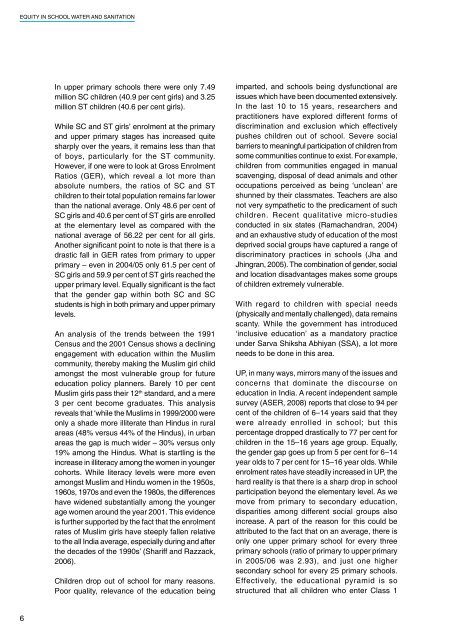Equity in School Water and Sanitation
Equity in School Water and Sanitation
Equity in School Water and Sanitation
You also want an ePaper? Increase the reach of your titles
YUMPU automatically turns print PDFs into web optimized ePapers that Google loves.
EQUITY IN SCHOOL WATER AND SANITATIONIn upper primary schools there were only 7.49million SC children (40.9 per cent girls) <strong>and</strong> 3.25million ST children (40.6 per cent girls).While SC <strong>and</strong> ST girls’ enrolment at the primary<strong>and</strong> upper primary stages has <strong>in</strong>creased quitesharply over the years, it rema<strong>in</strong>s less than thatof boys, particularly for the ST community.However, if one were to look at Gross EnrolmentRatios (GER), which reveal a lot more thanabsolute numbers, the ratios of SC <strong>and</strong> STchildren to their total population rema<strong>in</strong>s far lowerthan the national average. Only 48.6 per cent ofSC girls <strong>and</strong> 40.6 per cent of ST girls are enrolledat the elementary level as compared with thenational average of 56.22 per cent for all girls.Another significant po<strong>in</strong>t to note is that there is adrastic fall <strong>in</strong> GER rates from primary to upperprimary – even <strong>in</strong> 2004/05 only 61.5 per cent ofSC girls <strong>and</strong> 59.9 per cent of ST girls reached theupper primary level. Equally significant is the factthat the gender gap with<strong>in</strong> both SC <strong>and</strong> SCstudents is high <strong>in</strong> both primary <strong>and</strong> upper primarylevels.An analysis of the trends between the 1991Census <strong>and</strong> the 2001 Census shows a decl<strong>in</strong><strong>in</strong>gengagement with education with<strong>in</strong> the Muslimcommunity, thereby mak<strong>in</strong>g the Muslim girl childamongst the most vulnerable group for futureeducation policy planners. Barely 10 per centMuslim girls pass their 12 th st<strong>and</strong>ard, <strong>and</strong> a mere3 per cent become graduates. This analysisreveals that ‘while the Muslims <strong>in</strong> 1999/2000 wereonly a shade more illiterate than H<strong>in</strong>dus <strong>in</strong> ruralareas (48% versus 44% of the H<strong>in</strong>dus), <strong>in</strong> urbanareas the gap is much wider – 30% versus only19% among the H<strong>in</strong>dus. What is startl<strong>in</strong>g is the<strong>in</strong>crease <strong>in</strong> illiteracy among the women <strong>in</strong> youngercohorts. While literacy levels were more evenamongst Muslim <strong>and</strong> H<strong>in</strong>du women <strong>in</strong> the 1950s,1960s, 1970s <strong>and</strong> even the 1980s, the differenceshave widened substantially among the youngerage women around the year 2001. This evidenceis further supported by the fact that the enrolmentrates of Muslim girls have steeply fallen relativeto the all India average, especially dur<strong>in</strong>g <strong>and</strong> afterthe decades of the 1990s’ (Shariff <strong>and</strong> Razzack,2006).Children drop out of school for many reasons.Poor quality, relevance of the education be<strong>in</strong>gimparted, <strong>and</strong> schools be<strong>in</strong>g dysfunctional areissues which have been documented extensively.In the last 10 to 15 years, researchers <strong>and</strong>practitioners have explored different forms ofdiscrim<strong>in</strong>ation <strong>and</strong> exclusion which effectivelypushes children out of school. Severe socialbarriers to mean<strong>in</strong>gful participation of children fromsome communities cont<strong>in</strong>ue to exist. For example,children from communities engaged <strong>in</strong> manualscaveng<strong>in</strong>g, disposal of dead animals <strong>and</strong> otheroccupations perceived as be<strong>in</strong>g ‘unclean’ areshunned by their classmates. Teachers are alsonot very sympathetic to the predicament of suchchildren. Recent qualitative micro-studiesconducted <strong>in</strong> six states (Ramach<strong>and</strong>ran, 2004)<strong>and</strong> an exhaustive study of education of the mostdeprived social groups have captured a range ofdiscrim<strong>in</strong>atory practices <strong>in</strong> schools (Jha <strong>and</strong>Jh<strong>in</strong>gran, 2005). The comb<strong>in</strong>ation of gender, social<strong>and</strong> location disadvantages makes some groupsof children extremely vulnerable.With regard to children with special needs(physically <strong>and</strong> mentally challenged), data rema<strong>in</strong>sscanty. While the government has <strong>in</strong>troduced‘<strong>in</strong>clusive education’ as a m<strong>and</strong>atory practiceunder Sarva Shiksha Abhiyan (SSA), a lot moreneeds to be done <strong>in</strong> this area.UP, <strong>in</strong> many ways, mirrors many of the issues <strong>and</strong>concerns that dom<strong>in</strong>ate the discourse oneducation <strong>in</strong> India. A recent <strong>in</strong>dependent samplesurvey (ASER, 2008) reports that close to 94 percent of the children of 6–14 years said that theywere already enrolled <strong>in</strong> school; but thispercentage dropped drastically to 77 per cent forchildren <strong>in</strong> the 15–16 years age group. Equally,the gender gap goes up from 5 per cent for 6–14year olds to 7 per cent for 15–16 year olds. Whileenrolment rates have steadily <strong>in</strong>creased <strong>in</strong> UP, thehard reality is that there is a sharp drop <strong>in</strong> schoolparticipation beyond the elementary level. As wemove from primary to secondary education,disparities among different social groups also<strong>in</strong>crease. A part of the reason for this could beattributed to the fact that on an average, there isonly one upper primary school for every threeprimary schools (ratio of primary to upper primary<strong>in</strong> 2005/06 was 2.93), <strong>and</strong> just one highersecondary school for every 25 primary schools.Effectively, the educational pyramid is sostructured that all children who enter Class 16












